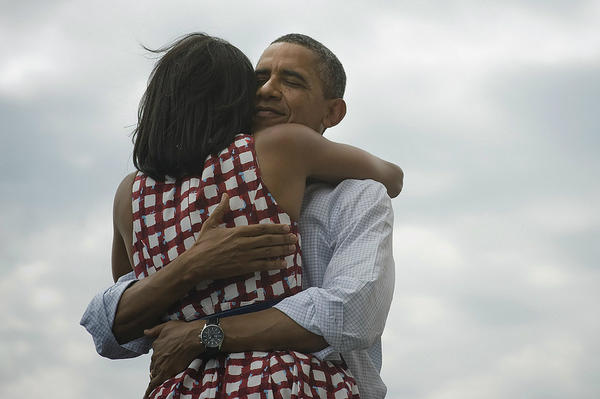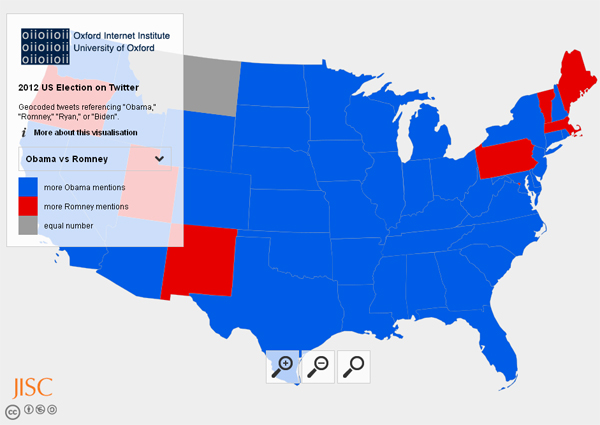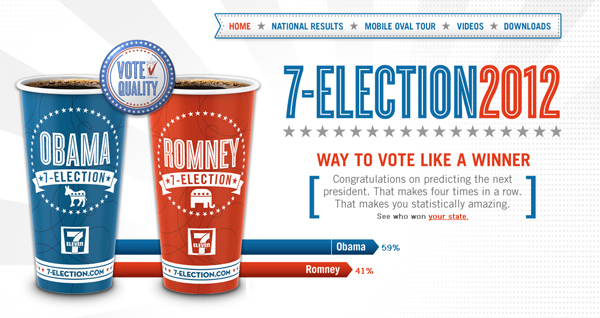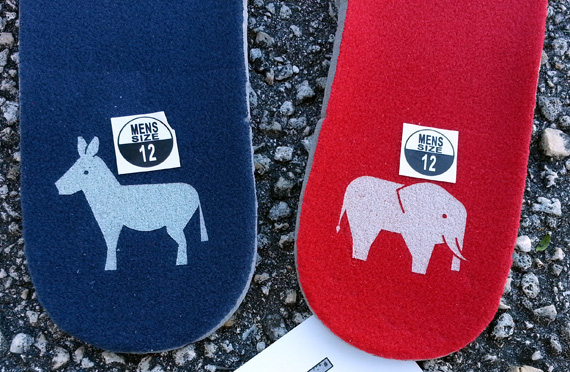The 2012 presidential election in the USA was definitely the first social media political election across the globe. Now, with the rapid development of the web and technology, when digital sources help people sharing their choices in all fields, the winner is the one who manages to establish its strong presence on the web, be it a consumer brand or a president. Since digital is now the most powerful media to influence the opinions of the digital-savvy, tech-embracing public, from the “digital” point of view, the election was destined to be won by not Mitt Romney but Barak Obama, who dominated on the web as a result of a well-thought digital promotion policy. 
In 2012, digital has become one of the driving forces of the US Presidential election, but not the only one. Candidates have also utilized a series of conventional approaches to promote their political views—well-recognized faces supported Obama and Romney, and even consumer brands tapped into the movement by encouraging people to go and vote using a range of quite creative approaches. Below you may find a short recap of hand-picked election-related initiatives, unveiled over the past months, in following categories: Social media support, Brands support, and Celebrity support.
Social media support
“Ironically, digital may return us more to an era in which personal interaction becomes critical to earn votes. It may not enable a politician to shake a hand or kiss a baby, but it can come close. As digital grows, so will voter demands for candidates to use digital to be responsive, relatable, and present in their own world,” writes Interbrand in The Political Issue dedicated to the election.
Social media turned to be the prime platform for interactions and inspiration during the election. The fact that Obama’s message with the “Four more years” photo, where he’s hugging his wife, Michele Obama, became the most retweeted tweet ever (over 800,000 tweets) and got over 4 million likes since Wednesday, November 6 within an hour on Facebook speaks for itself. “Guinness said a post made just after midnight on Obama’s official Facebook page received the Most likes on a Facebook item ever, doubling in less than 24 hours the previous records of 1,662,336 and surpassing by four times the record for Most likes on a Facebook item in 24 hours, which stood at 588,243,” writes www.latintimes.com. Facebook is a mirror of real popularity—after Romney lost, his ratings decreased on the 1st social media platform. “In the three days after Romney conceded the Presidential election to Barack Obama, more than 50,000 users have unliked his page,” Mashable reports. Now, Romney has slightly over 12 million likes on FB, while Obama has more than 33 million likes.
Photo: Obama’s «Four more years» photo, twitter.com/BarackObama (click to enlarge)
Digital, social media giants have become a powerful supporter of both of the candidates, helping bring the election’s spirit to each owner of a computer, laptop or mobile device with an internet connection, and informing people on the election’s progress. Audience itself became media by discussing, commenting and influencing their circles, multiplying the promotions’ effect.
Ahead of the election, Facebook launched an interactive map, allowing to view the anonymized representation of people on Facebook who clicked an Election Day prompt to share with their friends that they had voted in the 2012 US election. Facebook also collaborated with CNN to launch the Election Insights platform earlier this year to display the real-time number of people talking about President Barack Obama and Republican presidential nominee Mitt Romney as well as their “right hands.”
YouTube, the video service, which provides live-streaming of the must-watch events around the globe, covered the 2012 US election on the YouTube Elections Hub, which served as a channel for key political debates and moments before and during the election. In early 2012, Baraсk Obama and Mitt Romney also hosted so called hangouts on Google+, leveraging strengths of the digital giant’s social network.
Apart from being a great platform for sharing opinions on the election, Twitter has also served as an exit-poll survey, predicting the outcome of the US election. If the micro blogging service can help predict box offices, why can’t it do the same for the election? Guardian unveiled a visual presentation of a study “carried out in order to see how visible both major presidential candidates are on Twitter based on the users’ Twitter references to candidates’ names.”
Photo: Guardian’s infographics 2012 US Election on Twitter, www.guardian.co.uk (click to enlarge)
Instagram’s engagement was less massive than the one of FB’s or Twitter, but in fact it also was a popular platform to share voting impressions. On the election day, Instagram shared over 680,000 images carrying the “vote” hashtag. “Photos tagged with the words ‘election’ or its variations saw 250,000 photos. Instagram photos tagged with the #obama hashtag clock in at 1.27 million, while users posted the #romney hashtag just 260,700 times,” writes www.digitaltrends.com. As to Pinterest, Obama’s camp definitely lead its polls (view the infographics from blog.curalate.com).
In addition to fostering their social media presence, the candidates released the election-themed apps.
Celebrity support
Movie, music and sports celebrities’ influence on people’s mind is indisputable, and of course the camps of Obama and Romney invited the most recognized faces to share their passion towards the election on the whole and one of the candidates in particular. The 2012 US presidential election were heavily backed by a powerful star-studded army. For instance, Leonardo DiCaprio and Tobey Maguire conceived and produced their Vote4Stuff nonpartisan campaign to encourage people go and vote for their tomorrow—the video created to help spread the message also features Jonah Hill, Joseph Gordon-Levitt, Zac Efron, Benicio Del Toro, Edward Norton, Ellen Degeneres, Selena Gomez, Sarah Silverman, and Amanda Seyfried.
In early 2012, Barack Obama’s team released a 17-minute documentary “The Road We’ve Travelled,” narrated by Tom Hanks, who thus became one of the first celebrity supporters of Obama. Other globally recognized faces in the entertainment business, including George Clooney, Madonna, Beyonce, Steven Spielberg, Katy Perry, Warren Buffett, Hugh Hefner and more then joined to support the Democrat candidate (Obama), while Kid Rock, Donald Trump, Lindsay Lohan, Sylvester Stallone, Cindy Crawford, Clint Eastwood and others backed the Republican’s one (Romney). In June 2012, Forbes wrote, “Romney’s Got Billionaires, But Obama Has Hollywood.”
Brands support
In fact, candidates are just like consumer brands, and to some extends their promotions are based on the rules, which usually help brands win. During this election, the consumer labels didn’t support any candidate, they just generated buzz around the presidential campaign and in their own way, tried to predict the election’s results with the help of shoppers.
The 7 Eleven convenience chain encouraged its consumers to vote by purchasing their coffee in a cup featuring either Obama or Romney design—they could share their opinion using this “coffee” and thus become ambassadors of one of the candidates for the time they were holding the cup in their hand and drinking their hot coffee. According to 7-11’s “cupelection”, Obama got 51%, while Romney ended up with 49%. Bliss, the American spa and beauty brand, also led its poll based on consumers’ choice—the brand offered shoppers who spent $50 and more on www.blissworld.com to chose one of the body lotions, orange “O” Bama or “Mint” Romney at the checkout—the result is 54% to 46%, Obama won (or, just most consumers preferred oranges to mint).
Photo: A snapshot from the 7-11 «presidential» page, www.7-eleven.com/7-Election (click to enlarge)
There we also other ways to express your passion towards the candidate’s programs. For instance, Cheetos created two huge portraits of Romney and Obama using 2,000+ orange snacks and asked the audience to visit the “Vote 4 the Big Cheese” app and tell, which one looks best (Obama wins again with 57%). Find more campaigns on CreativityOnline—all of them were predicting Obama’s victory. And it turned true. Maybe there’s really something in this form of people’s opinion analyze, despite all light-hearted nature of these initiatives, aimed to promote the brands rather than the candidates.
One of the biggest diplomats in the brands family was Nike, which has released special-edition Air Jordan 1 sneakers, featuring the symbols of both parties, the elephant and the donkey, on the insoles. And the less delicate, but a hilarious guerilla outdoor campaign was the one called Gum Election (not related to any particular brand), which just like in 2008, invited people to vote against a candidate by placing a piece of chewed gum onto the print portraits of Obama and Romney.
Photo: Nike Air Jordan 1 “Election Day”, www.sneakernews.com (click to enlarge)
Of course, neither social media, nor celebrities and consumer brands can bring a candidate a victory, but they definitely contribute to the success. The messages and facts are more important than the media, but platforms can help deeds shine brighter. Four years ago, Facebook and Twitter were great, but not as powerful as now, Instagram and Pinterest didn’t exist at all, and iPads weren’t even about to be launched. Technologies have made a huge step further, so did the presidential campaign, from the promotional point of view. Can you ever predict what the election will look like in 2016 with all new services, new mobile tech opportunities, and even new social media channels?



